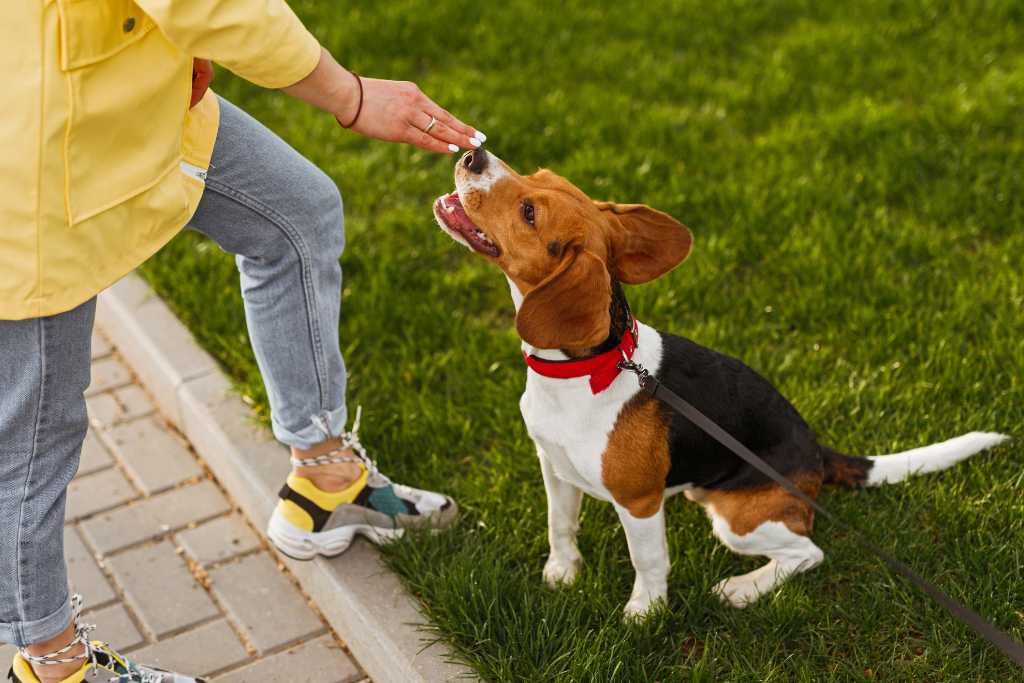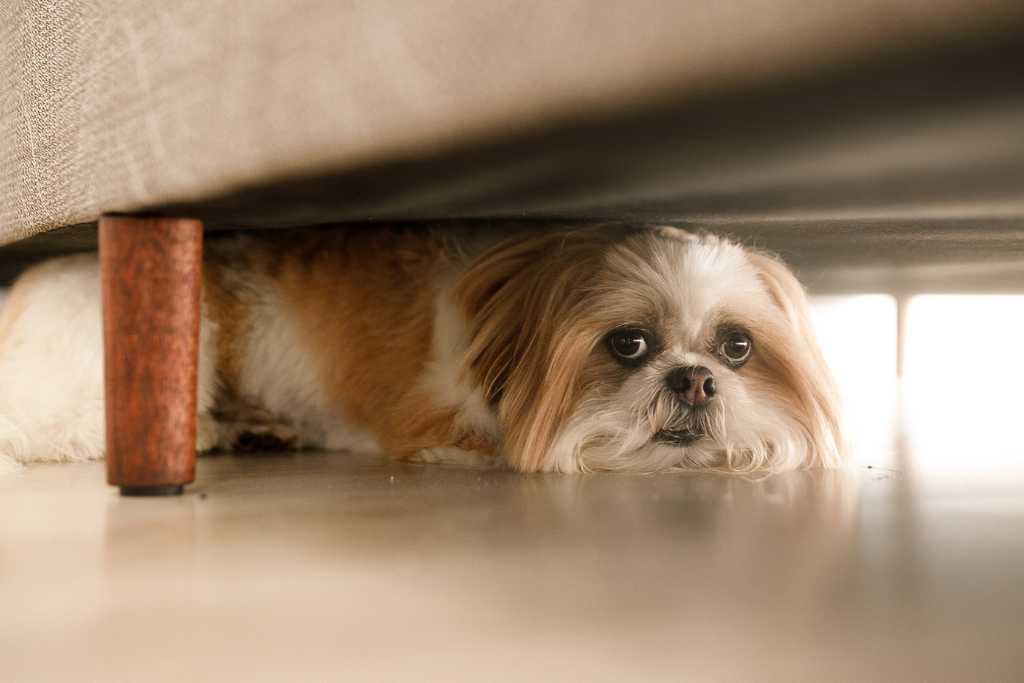MORE TO SHIP FREE 🚚
NICE. SHIPPING IS FREE 🎉
MORE TO REDEEM GIFT 🎁
YAY. REDEEM A FREE GIFT 🥳
YOUR CART IS EMPTY. SHOP NOW.
Rescue dogs often come from difficult and traumatic situations, which can cause them to have low self-esteem and confidence. Whether your dog displays his insecurities through whining, cowering, running away, or fear aggression, his lack of confidence is a hurdle he can’t solve on his own. He needs your help and it is important to take steps to help him build confidence so he can lead a happier and healthier life. Luckily, there are lots of confidence-building exercises for dogs. This week, we embarked on a mission to explore some tried and tested confidence-building games and exercises. We've compiled them in this article for your perusal.

Low confidence in dogs can manifest itself in many ways, some of which may be easy to spot while others may require a more in-depth understanding of your pet's behaviour. Here are some common signs to look out for:
Fearfulness
Fearful behaviour is often one of the most noticeable signs of low confidence in dogs. Dogs with low confidence may be scared of loud noises, unfamiliar objects or people, or other animals. They may also hide or cower when approached.
Aggression
Dogs with low confidence may also display aggression towards other dogs or people. This can be due to a lack of trust in their environment, which causes them to react defensively. Often, a special no-pull harness and leash or muzzle may be necessary.
Avoidance
Dogs with low confidence may try to avoid new situations, people, or objects. They may also hide or run away when faced with something unfamiliar.
Excessive barking or howling
Dogs with low confidence may bark or howl excessively as a means of expressing their discomfort or anxiety. This can be especially noticeable when they are left alone at home or in an unfamiliar environment. Using an ADAPTIL Calm Behaviour Training (For Anxiety) Diffuser Kit for Dogs may help but read on to learn the various ways to boost your dog’s confidence.

Basic obedience training
Dogs are most comfortable when there are clear rules to guide them. Rules mean predictability, and knowing what’s expected of them can help stave off feelings of fear and anxiety. Whether your rescue has spent time in a home or is coming to you after years on the street, treat them as if they’ve never been trained before. Start with the most basic lessons, like “sit” and name recognition. Teaching him basic obedience will make his environment more predictable. Basic obedience training helps him know what you’re asking of him and how he should respond.
Of course it goes without saying that you should train your rescue with positive reinforcement techniques. Never use punishment-based training methods with your rescue. Nothing can destroy a timid dog’s confidence faster than verbal or physical punishment. Positive reinforcement training will show your dog good things happen when they behave in a specific way. Instead of breaking them down when they do something wrong, build them up when they do something right. It shows them they can be in control to bring about positive scenarios.
Finally, with all types of training, consistency is the key to success. Establishing a routine and sticking to it can help your dog feel more secure and confident in their environment.

Targeting dog training
Targeting dog training is a positive reinforcement training technique in which a dog is taught to touch a specific object, such as a hand, a target stick, or a specific spot, with their nose or paw. Since dogs naturally explore the world with their noses, nose targeting - getting your dog to touch a target with his nose - is the easiest to work with. Nose-targeting draws your dog’s eye-contact and attention from a worrisome stimulus to a pleasant one. Targeting can be fun and many dogs love it, partly because it’s easy to do, and it pays off well.They get a treat or praise by simply touching the target like a hand or stick with their noses.
Here’s how targeting works. Hold out your hand (the target) in front of your dog, at nose level or slightly below. When he sniffs it, click your clicker (or use a verbal marker, such a word) and give him a treat. Choose a small, soft training treat that can be quickly consumed so that you can move on with the training. Remove your hand, then offer it again. Each time he sniffs, ‘click’ and treat or praise. If he stops sniffing, rub a little tasty treat on your palm and continue with the game.
Your pup will eventually realise that he can make you ‘click’ and treat by bumping his nose against your hand. Now, his “touch” behaviour becomes deliberate, rather than incidental. When you notice him deliberately bumping his nose into your hand, add a verbal cue. You can say “Touch!” each time you offer your hand to him. He’ll very quickly learn that “Touch!” means a bump on your hand for a treat or praise! Make it a game, so he thinks it’s the most fun thing in the world. As he familiarises himself with the game, up the level and start offering your hand in different places. Let him move around or jump up to touch it. Gradually decrease your reinforcement. Allow him to touch several times before giving him his treat.
Once he loves the game, now it’s time to try it out when he is a little bit nervous about something. When you notice your dog cowering, tail between his legs, hold out your hand and say “Touch!” so that your dog takes his eyes away from the scary object or person, to sniff your hand. Acknowledge his action with a ‘click’ or verbal cue, and give him a treat and a big praise! This will take his attention away from the scary object. Do this every time he sees the scary object and soon he’ll learn that the object is not scary but good because he gets to participate in a fun game and be rewarded with a yummy treat!

“Treat and Retreat” dog training
"Treat and retreat" is a positive reinforcement training technique used to help dogs feel more comfortable and less fearful in certain situations. This training method involves gradually introducing a dog to a stimulus that they are afraid of or unsure about, such as other dogs or people, in a controlled and safe manner. Its development is attributed to two well-known trainers: Dr. Ian Dunbar, veterinary behaviourist and founder of the Association of Professional Dog Trainers, of Berkeley, California; and Suzanne Clothier, who trains in St. Johnsville, New York.
The trainer begins by keeping a safe distance from the stimulus (the object or person that the dog is afraid of) and rewards the dog with treats or praise for remaining calm and relaxed. As the dog becomes more comfortable, the trainer can gradually decrease the distance between the dog and the stimulus, continuing to reward calm behaviour with treats and praise. If the dog becomes anxious or fearful at any point during the training, the trainer retreats to a safe distance and rewards the dog for calm behaviour. This allows the dog to feel more in control of the situation and less overwhelmed by the stimulus.
The goal of "treat and retreat" training is to help the dog develop a positive association with the stimulus and to build their confidence in challenging situations. If you see increased signs of reluctance with the decreased distance, you’ve decreased the distance too quickly. Go as slowly as necessary to keep your dog happy about this game; you want him moving toward the “scary” object or person voluntarily. With consistent and patient training, your rescue can become more comfortable and less fearful around stimuli that once caused him anxiety.

Engage-Disengage dog training
This technique involves rewarding dogs for voluntarily disengaging from a stimulus that might trigger an unwanted behaviour, such as barking or lunging. To begin this training, the dog is introduced to a stimulus, such as another dog or a person, from a safe distance. The moment the dog looks away or disengages from the stimulus, the trainer immediately rewards them with a treat, verbal praise, or a toy.
With repeated training sessions, the dog learns to recognize the trigger and automatically disengage from it, with the expectation of being rewarded for doing so. As the dog progresses, the trainer gradually reduces the distance between the dog and the trigger and eventually can train the dog to remain calm in close proximity.
The engage-disengage technique is often used to help dogs who display reactive or aggressive behaviours, as well as those who are fearful or anxious in certain situations. It helps the dog build confidence and trust in their handler and teaches them a new way to respond to stressful situations.

Every dog should have a place that he can retreat to, and it’s entirely his. When things get scary, he can retreat to his quiet space to calm down and relax. This place should be comfortable and quiet, away from human foot traffic. Somewhere no one can bother him. You can set up a quiet space by placing a dog kennel, a covered dog bed, or even a dog carrier (double up as a kennel) in a hidden corner.
Some rescue dogs actively seek seclusion even when they don’t have a designated area. If you frequently find them under the bed or behind the sofa, consider that their personal quiet space. Leave them alone when they are at their hiding location. Having time alone to decompress is essential for the dog’s emotional well-being. Especially with new rescues, being around strange people can be overwhelming.

Confidence building should be an ongoing process. Simple activities like feeding your dog using food puzzles and getting him involved in nosework games can make him more confident too. Constantly engage your rescue with these activities and remember to always keep things fun and positive. The more positive experiences your dog has, the more eager he will be for new adventures. Building confidence in your rescue dog is an essential part of providing him with a happy and healthy life. Recognise signs of low confidence and take steps to boost his self-esteem. Help your pup become more comfortable and confident in any environment. Remember to be patient, consistent, and loving in your approach, and your rescue dog will surely thrive.

Comments will be approved before showing up.
Your dog's body detoxes naturally, but daily exposure to chemicals and pollutants can overwhelm them. Learn safe ways to support...
Arthritis can make movement painful for dogs, but the right diet can help improve comfort and mobility. Learn how weight...
Dogs can eat raw food, but random meat pieces aren’t balanced. Learn the challenges of DIY raw feeding and why...



